Everything about Google AI Overviews: How things have changed from SGE to now
We’ve put together a hub article with everything about AI Overviews—how they work and how they’ve changed over time. We’ll keep it updated with the latest changes, so bookmark it and stay in the loop!
What are AI Overviews?
AI Overviews (AIOs) are AI-powered snippets that appear at the top of the Google SERP and offer an immediate, extended answer to the user’s query. Google pulls information from various sources to provide insights directly on the search page, eliminating the need to click through multiple websites.

AI Overviews share in search
According to our May 2025 study, about 30% of keywords trigger AI Overviews in US SERPs. This data spans five states but covers a wide geographic range across the US.

The numbers looked noticeably different in 2024. As shown in the chart, the share of AI Overviews across the USA was around 19% in November 2024. This is nearly the same share as January of that year. In June and July 2024, the share was roughly half of what it was in November. By August 2024, AI Overviews appeared in about 12.5% of desktop searches.

According to SE Ranking’s latest study, the niches with the highest percentage of AI Overviews include Relationships (around 61%), Business (around 57%), Education (around 50%), and Food & Beverage (around 46%).

But don’t let the seeming insignificance of these numbers fool you. AI’s impact on search is more like an unraveling yarn. More queries will generate more AI snippets over time.
Your site’s visibility in AI Overviews and beyond
You can use SE Ranking’s AI Search toolkit to measure, understand, and improve your site’s visibility in AI Overviews and other AI search engines. With its help, you can:
- Learn how much your site already gets cited in AI Overviews. Track brand mentions and links, your average position, and other top-level metrics.
- Dive deep to learn which snippets of text get quoted. Analyze AIO text copies to learn how to get features in even more AIOs.
- Analyze your competitors’ performance. Get an overview of any site’s presence in AIOs, benchmark your results against your rivals.
- Evaluate AIO volatility for your top keywords. Set up daily tracking to monitor every SERP fluctuation.
- Monitor your brand in ChatGPT responses—track mentions and links, analyze competitor data, compare performance, and review linked sources, positions, and frequency of mentions.
- AI Mode, Perplexity, and other AI search engines tracking are coming soon.

Beyond tracking your AI visibility, maintaining a consistent brand presence across all channels reinforces the signals AI systems use. Teams using tools like SE Ranking for SEO tracking and Planable for social media coordination can ensure their expertise is visible wherever their audience searches.
Queries that trigger AI Overviews
AI Overviews show up for longer, more informational searches. According to our May 2025 study, 10-word queries trigger AI Overviews over five times more often than single-word searches (69.21% vs. 12.78%).

AI Overviews are reserved to answer complex questions, where Google feels it can add value beyond the search results.
According to seoClarity Research, over 96% of AIOs are triggered by informational user intent, while they appear in transactional queries only 1.2% of the time.
CONFIRMED: AI Overviews still almost entirely INFORMATIONAL in intent
— Mark Traphagen 🏳️🌈 (they/them) (@marktraphagen) September 17, 2024
We looked at over 1 million keywords from our @seoClarity Research Grid (US) and found that over 96% have informational user intent.
AIOs show in purely transactional queries only 1.2% of the time. pic.twitter.com/I4rlpkdplM
Our recent study spanning 5 states across the US confirms that as search volume increases, the frequency of AI Overview appearances drops significantly. For keywords with a search volume between 0 and 10, AI Overviews appear at a rate of 30–31% across the board. This is because highly specific long-tail keywords, which are more likely to trigger AIOs, typically have low search volumes.
Locations where you can see AI Overviews
Current situation (October 2025)
In late May, at Google I/O 2025, the company announced the expansion of AI Overviews to new countries and languages. With this rollout, AI Overviews are now available in over 200 countries and territories, and in more than 40 languages.
Find the latest list of countries where AI Overviews are available here.
What was it like before?
- May – August 2023: 🇺🇸United States with Search Labs only
From the initial launch of the first version of SGE until August 2023, it was available exclusively in the US and only to Search Labs users enrolled in the experiment.
- August 2023 – May 2024: 120+ countries with Search Labs only
In August 2023, the generative AI experience in Search Labs was expanded to India and Japan. By November 2023, it had been rolled out to more than 120 additional countries and territories.
- May – August 2024: 🇺🇸United States without Search Labs and other 120+ countries with Search Labs only
After the official launch, AI Overviews became available to all users in the US. Others had to enable Search Labs to access these AI-powered results.
- August – October 2024: 6 countries without Search Labs
Google announced on August 15th 2024 that AI Overviews were rolling out in:
- 🇺🇸United States
- 🇬🇧United Kingdom
- 🇧🇷Brazil
- 🇲🇽Mexico
- 🇮🇳India
- 🇮🇩Indonesia
- October 2024 – March 2025: 100+ countries and territories worldwide without Search Labs + Incognito mode
In October 2024, AI Overviews were rolled out in over 100 countries and territories worldwide, no longer requiring Search Labs access. Plus, users could get them in any of the currently supported languages, including English, Hindi, Indonesian, Japanese, Portuguese, and Spanish.
Google also began showing AI Overviews for Incognito mode and users who are not signed in.
- March – May 2025: Rollout across Europe
In early March 2025, Google began testing AI Overviews in Europe. They were seen in testing in Germany and Spain, with an SEO expert noting similar trials in Switzerland and Italy.
In late March 2025, Google officially rolled out AI Overviews in European countries. Here was the official list of supported European territories for AI Overviews at the time:
- Austria
- Belgium
- Germany
- Ireland
- Italy
- Poland
- Portugal
- Spain
- Switzerland
- United Kingdom
In these countries, AI Overviews were limited to users 18 and up.
Plus, Google added German, Italian, Polish, and French to its list of AIO-supported languages.
Since May 2025, Google has been showing its AI Overviews feature to users in Turkey, Sweden, Romania, France, the Netherlands, and Persian-speaking countries.
Typical AI Overviews layouts
Current view (October 2025)
The typical layout of AI Overviews closely resembles a featured snippet. The most common format appears as follows:

On the left, most of the screen is occupied by the answer, displayed on a white or semi-transparent blue background. The response is often presented as formatted text, including paragraphs, bullet points, headings, and more.
Google highlights the key information in blue—as shown in the screenshot above.
To the right of the answer is a list of sources from which the response was generated. Both the answer and sources are often partially hidden to save space in the search results for users who want to explore other results. If a user is interested in the AI-generated answer, they can expand it by clicking Show more and Show all.



Below the response, you will see a note:
AI responses may include mistakes. Learn more
You’ll also see a Dive deeper in AI Mode button below the answer—click it to explore the topic in more detail. In some cases, you may instead see an Ask anything box. Simply type a query and press Enter to go straight to AI Mode results.
Google is experimenting with the AI Mode button and experience attached to AI overviews.
— SERP Alert ⚡️ (@SERPalerts) August 25, 2025
Instead of the standard ‘dive deeper in AI Mode’ text, they’re instead experimenting with an additional search box with the AI Mode icon with the button text ‘ask anything in AI Mode’.
It… pic.twitter.com/KX2zsGlLJi
We break down what AI Mode is and how it works in our article.
For YMYL (Your Money or Your Life) queries, disclaimers are included, encouraging users to seek professional advice. For example:


To the right of the disclaimer, users can also rate the generated response.

With Search Labs, Google allows you to copy or export the text.

Google’s AI Overviews feature also shows options like Explain this, Related images, and Copy text when you highlight text in an AI-generated overview. Instead of opening a new page, these actions appear in a tray at the bottom of the screen.
Send a video of the action when you click on “Explain this”
— 松下 聡太郎(Matsushita Sotaro) (@w55UMqzEVGqD7FP) August 19, 2025
It appears that an AI Overview on the selections will be developed. pic.twitter.com/n8n3KPgnti
There are countless AI Overviews layouts, depending on the query and niche. Here are a few examples:
- Plans:

- Tables with images:

- Shopping-focused results, described in more detail below.

- Text with an image or video:
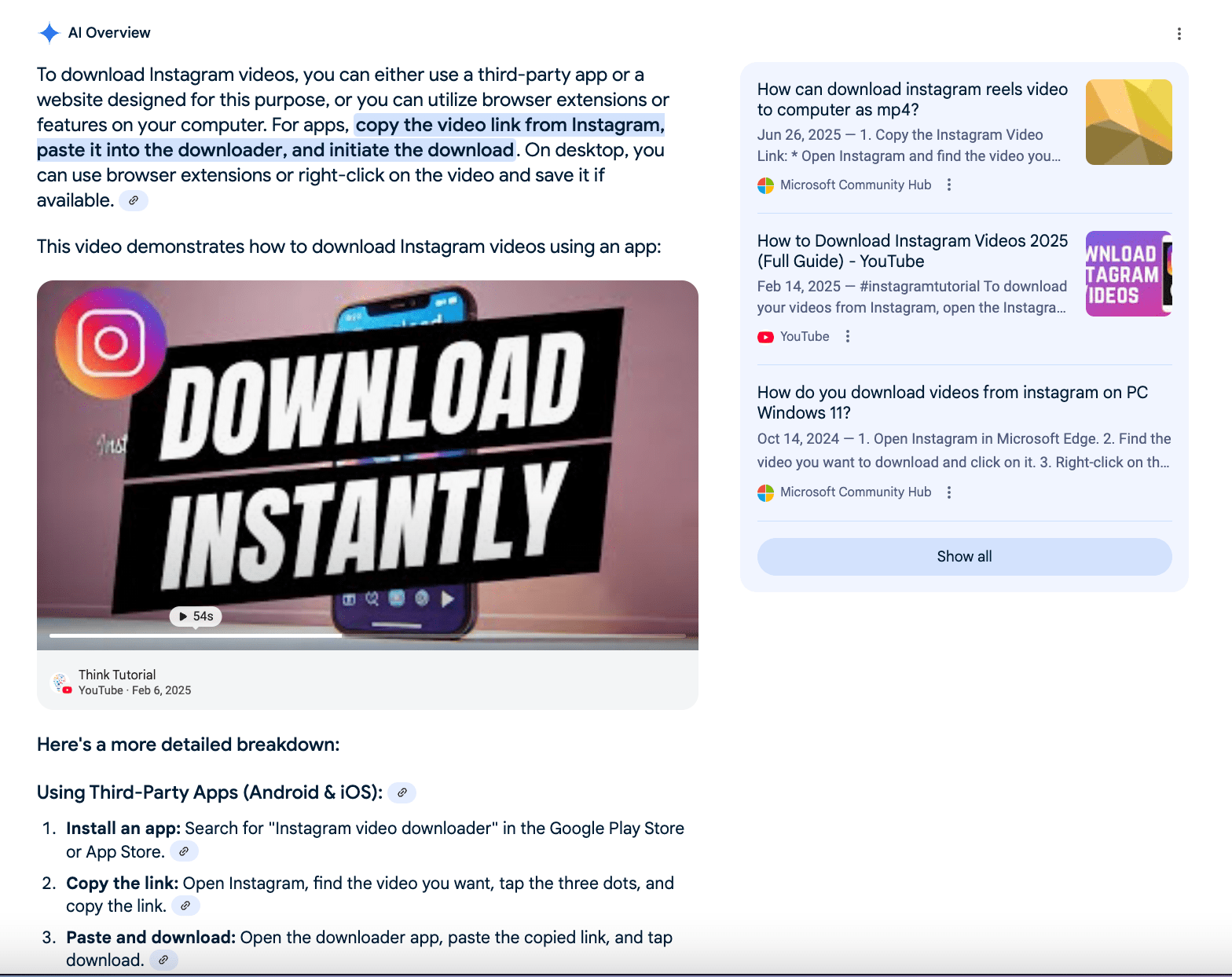

- Multiple YouTube videos with summaries
🆕 AI Overviews multiple YouTube videos in the answer. The usual structure is
— Gagan Ghotra (@gaganghotra_) July 13, 2025
heading -> paragraphs -> YouTube videos
and the same again …..
Mostly showing in AI Overviews which loads when clicking on dotted underlined words in answers that take to new search results… pic.twitter.com/lL0pz9lKlh
As of June 2025, Google has started embedding YouTube Shorts into AI-generated results. These clickable clips can be viewed directly on the search page.
Google AI Overview is now showing Shorts@rustybrick @brodieseo @gaganghotra_ pic.twitter.com/3xERBwuy9O
— Sachin Patel (@SachuPatel53124) June 5, 2025
- Recipes:

Note: In October 2025, Google began testing a revamped layout for its AI Overviews in recipe searches, aiming to make the experience more favorable for content publishers. Under the new design, recipe cards appear at the top of the results, while a shorter AI-generated overview and citations are placed at the bottom.
Meanwhile in the world of AIOs. This is much better Google. Instead of an untested AI Frankenstein recipe as the default response there is a basic recipe overview and rich result links. Credit where it’s due. cc @glenngabe @rustybrick pic.twitter.com/rIuaKYAY6U
— Inspired Taste (@inspiredtaste) October 4, 2025
In May 2025, Google began testing a new feature in its AI Overviews: query expansion tabs. These tabs appear at the top of the AI-generated summary and offer users related questions to explore. The first tab displays the original query, while the others present variations or related topics—each triggering a new AI Overview.
Google’s AI Overview just got a UI update — now showing question-based tabs in the SERP. @rustybrick @gaganghotra_ @brodieseo pic.twitter.com/LRBDy7gNht
— Sachin Patel (@SachuPatel53124) May 28, 2025
At the end of August 2025, Google began testing a new type of AI Overviews on desktop that integrates elements of the Knowledge panel. These tests remove the AI Overview label and display reference links in columns rather than in a single row.
Google is testing out a new type of AI overview on desktop that combines the knowledge panel result.
— SERP Alert ⚡️ (@SERPalerts) August 31, 2025
Instead of the standard AI overview format, they are removing the labelling and showing the reference links in columns rather than stacked in a row.
More details:… pic.twitter.com/MTod21M3GE
What did it look like before?
- SGE era
Previously, the AI-generated reply to the user query block had a different design. Here are key differences:
1. There was a different icon to indicate an AI-generated response. Additionally, a disclaimer was displayed next to it:
Generative AI is experimental. Info quality may vary.

A similar phrase can now be seen at the bottom.
2. There was an Ask a follow-up button that allowed users to ask any question related to the topic. Additionally, there were generated questions provided, which could be selected to receive answers.


3. As you may have noticed from the screenshots, the generated responses were highlighted in different colors. This is no longer the case.
4. Previously, for certain queries, a Generate button was available in cases where the AI-generated output didn’t appear automatically. Our study revealed that in 45,111 instances (45.1%), Google offered to generate an AIOs (SGE) answer via the Generate button.

5. The disclaimers for Your Money or Your Life queries were slightly different in the past. However, the core message remained consistent: Google is not the final authority, and users should consult qualified professionals.


6. The links were also displayed differently (explained in the next section).
Here are additional examples of what the initial first of AI Overviews (SGE) may have looked like:
- For local queries with a map:

- With a source block after each bullet point:

- Lists


You can find even more historical data in Barry Schwartz’s tweet.
I’m in! Google SGE here I come, for the next couple of hours! pic.twitter.com/GZqzJ7rwdw
— Barry Schwartz (@rustybrick) May 25, 2023
- June 2024
The interactive feature of AI Overviews was no longer available—users could no longer ask follow-up questions, and the generated questions at the end have been removed.
Feeling a little dumb because I watch AI Overview results every day but only just noticed that they seem to have lost the interactive part: the ability to ask a follow-up question, along with the suggested follow-up questions. pic.twitter.com/TAmHZtAj2B
— Mark Traphagen 🏳️🌈 (they/them) (@marktraphagen) July 31, 2024
Google also tested the Original/Simpler option. It’s the two-tab result with different content and sources (links) in the snippet.

- November 2024
AI Overviews were starting to look more like what we see now, but there were still a few small differences:
- The option to switch to AI Mode hadn’t appeared yet
- Google wasn’t highlighting the main text in blue
- The disclaimers at the end were worded a bit differently


At the time, Google was testing a Highlight button that let users highlight text within a snippet, triggering a related follow-up search (with citations) for continuous learning.
Whoa, this makes things interesting for AI Overviews on Google. A new ‘Highlight’ button is showing that allows users to highlight text within the snippet that then triggers another related search (with citations) for continuous learning. More details: https://t.co/frcuz4TdVh pic.twitter.com/ponxODidON
— Brodie Clark (@brodieseo) November 1, 2024
Google was also experimenting with a new format for its AI Overviews.
In this version, answers to broader queries were organized into categories, displayed in card-style blocks. Each block either presented a new AI Overview or linked to additional search results.
Google is testing a new AI overview box with a clickable ‘>’ symbol. It provides concise info and lets users refine their search, redirecting them to a more specific SERP. @rustybrick @gaganghotra_ @SERPalerts pic.twitter.com/7CnLFQpK5I
— Sachin Patel (@SachuPatel53124) November 22, 2024
Google also experimented with detailed comparisons in AI Overviews. When searching for two specific models using “vs,” the results might look like this:

Expanding the AIO results revealed more details, with flyout menus under each comparison point displaying long lists of specs:

Links in AIOs: placement, number, and sources
Current situation (October 2025)
In addition to the list of sources shown on the right, you can also see small favicons within the response opposite to every bullet. When tapping the icon, users will see links which used to generate that part of the answer.


Here’s how it looks on mobile devices: all links are accessed through site icons. You can tap a group of favicons to see pages where the AI sourced the answer from.
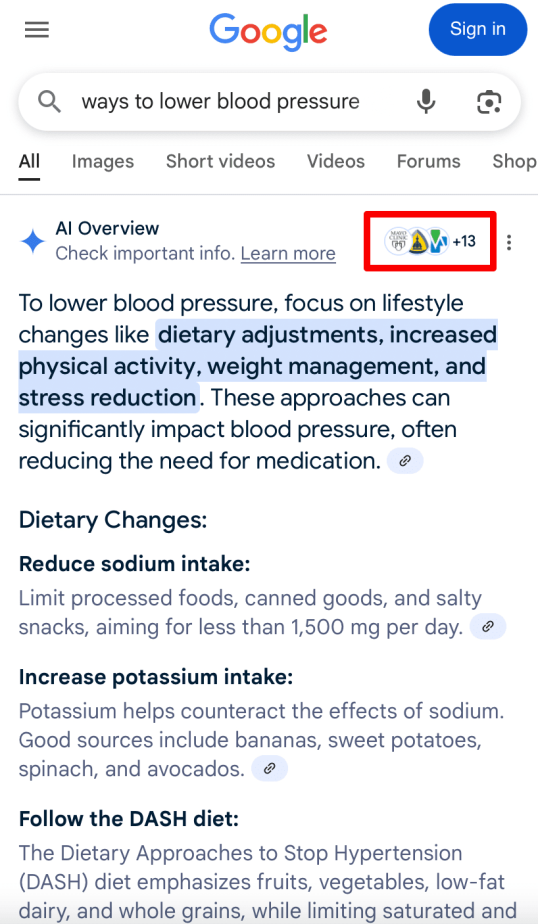
To give users reliable information, Google’s AIOs include blue anchor text hyperlinks to specific pages.

AI-generated snippets also include hyperlinks that guide users to additional Google Search results. Our data analysis shows that 43.42% of AI Overview responses contain links to Google organic results.
Google AI Overview appears with an underline, and when clicked, it redirects with a new query.@rustybrick @gaganghotra_ @brodieseo pic.twitter.com/Y6Df6bfxgn
— Sachin Patel (@SachuPatel53124) March 17, 2025
According to findings from our research study in May, the average number of links in AI Overviews is 13. Back in November 2024, the average was just 6.82 links.
What was it like before?
- SGE era
The snippet included websites on the right side. Each link card featured an image, a title (or H1), and a link (without any description). Unlike the current list format, these blocks were displayed as a carousel.

- January 2024
Carousels with links on the right started to disappear. Instead, link cards began appearing either beneath the AI response or embedded within it (accessible by clicking the arrow).


Sometimes, a carousel on the right and links within the response were present. Users could see additional carousels placed after every paragraph that get displayed upon clicking an arrow.

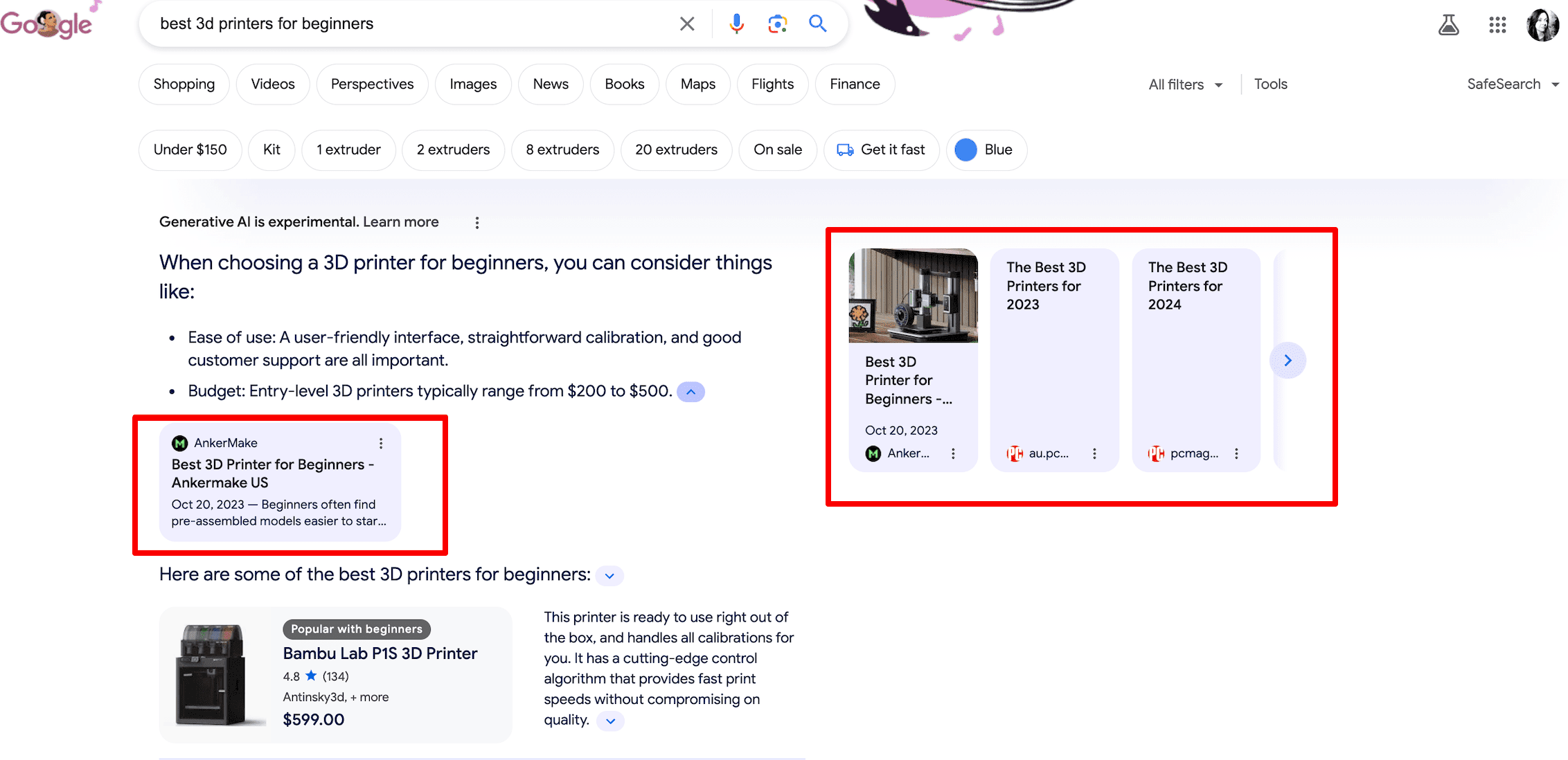
- June 2024
Google tested AI Overviews with link cards at the top, making those links more visible and more likely to be clicked.

However, it never moved beyond the testing phase.
Regarding the number of links in the AI snippet, our data showed the typical number of links in AI Overviews (formerly SGE) in February 2024 was 8. Data from July 2024 showed that the average number of links in AI Overviews was 7.2, compared to 5.5 links in June.
Shopping results
Current situation (October 2025)
Another AI Overviews feature with the potential to transform the e-commerce industry is Google Shopping results/products integration into the AI Overviews results for e-commerce queries. It looks like Google is actively building an e-commerce search ecosystem where generated information is combined with products users can buy directly.
For commercial queries, you’ll most often see an AI-generated response that includes product carousels.
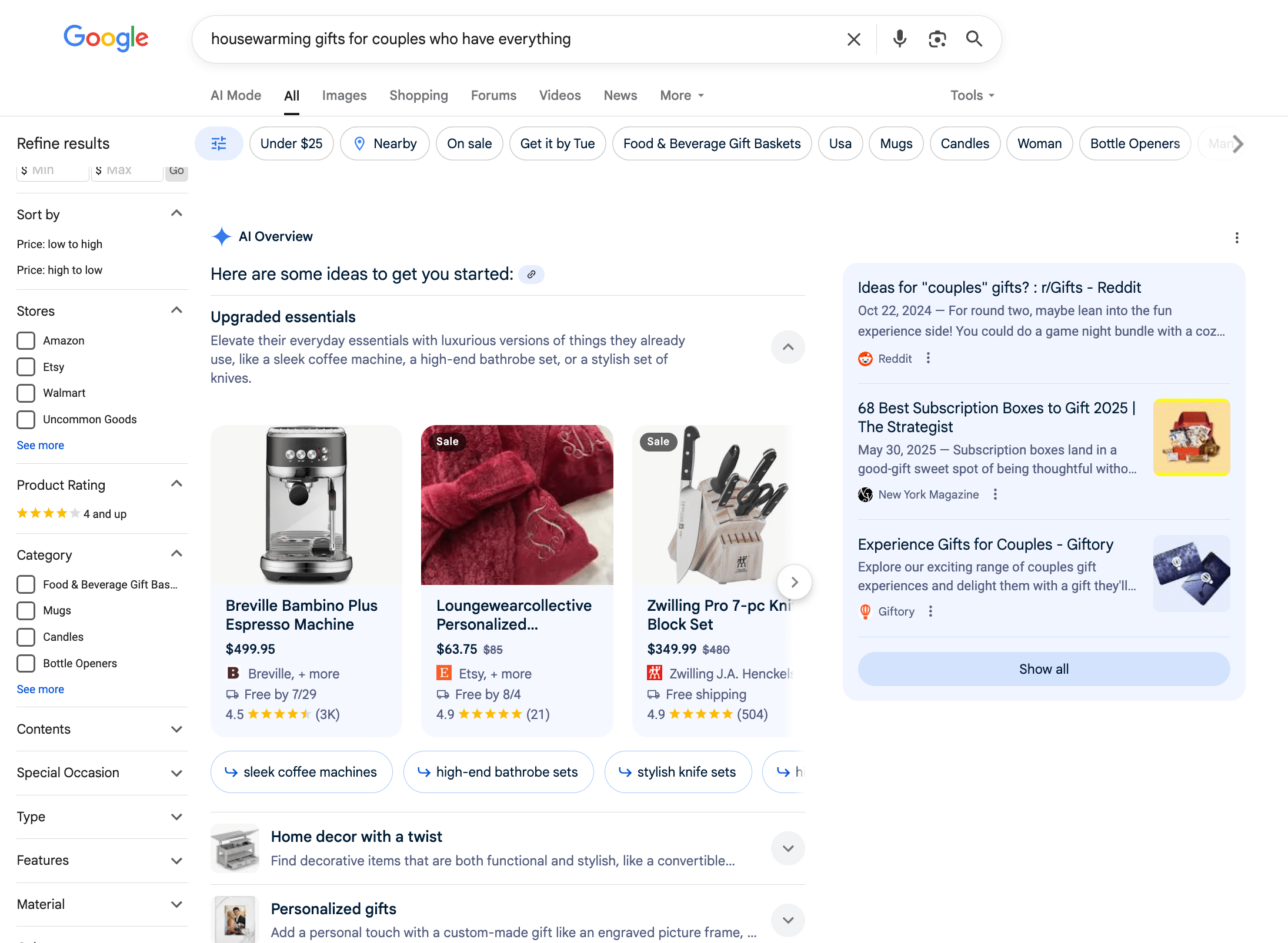
The AI Overview generates a browsable list that, when opened, displays clickable product carousels. Every product card includes info about rating, the number of reviews, price and URLs.
When clicking the product card, you will see a bigger, more detailed one on the right side with the product description, photos, descriptions, reviews, etc. Here, you can choose the website where you want to buy a product.

Google also provides query suggestions below the carousel. Clicking on them takes you to a new search results page for the selected query.

That’s because this new generative AI shopping experience is built on Google’s Shopping Graph, which has more than 35 billion product listings—making it the world’s most comprehensive dataset of constantly-changing products, sellers, brands, reviews, and inventory out there.
Additionally, Google Shopping includes an AI Overview feature called Researched with AI. It resembles product selection tips, with sources listed below and on the right side.

What was it like before?
- SGE era
Previously, shopping results could also be seen in AI Overviews in a different format. Usually, it was a list of products at the end of the response, like here:

You also got product descriptions that included relevant, up-to-date reviews, ratings, prices, and product images.

There was also a layout with multiple product cards sans descriptions.

According to Barry Schwartz’s observations, commercial queries included a layout like this featuring online stores:


In April 2024, Google also tested clarification tabs. However, we haven’t noticed this layout recently.
🆕 Google testing clarification bubble links with the SGE. pic.twitter.com/bFqCOQdIBJ
— Khushal Bherwani (@b4k_khushal) April 7, 2024
With SGE and AI Overviews, this is the first time organic shopping results have taken precedence over ads. Recently, Google started introducing ads into AI Overviews.
Ads in AIOs
Current situation (October 2025)
In May 2025, for the first time, ads began appearing directly within Google’s AI Overviews on desktop search for US users.
In June 2025, Google confirmed that ads can now appear within AI Overviews on both mobile and desktop—either above or below the summary, but not in both locations simultaneously.
Hi Yoav, Your ad could trigger to show either above/below AIO or within AIO, but not both at this time.
— AdsLiaison (@adsliaison) May 28, 2025
As you note, in this scenario, the exact match or broad match keyword could be eligible to trigger an ad above or below AIO, while only the broad match would be eligible to…
What was it like before?
Before the launch of AI Overviews in May 2024, there were no ads at all. Following the launch, testing began, and reports started emerging that ads would soon appear in AIOs.
- May 2024
In May, the first mention appeared that Google had been testing ads in AI Overviews. It stated that the company is moving forward with a full rollout because it helps people “quickly connect with relevant businesses, products, and services to take the next step at the exact moment they need them.”
- July 2024
Google said it again, that it will soon test ads within its AI Overviews.
- September 2024
The Verge shared news about ads in AI Overviews. The article explained AI-generated responses will include tips and suggest products to help.
- October – November 2024
After several months of testing, Google introduced ads within AI Overview snippets in October 2024. Initially, these ads were available only to mobile users in the US. They were first spotted in November 2024. Here’s what they looked like:

Ads labeled as Sponsored appeared below the generated response, highlighting ads are not the primary focus in this context.
AI Overviews placement
Google isn’t stopping with AIOs at the top of regular search results and has been testing out AI Overview snippets outside of the standard placement. You could see them in such places as:

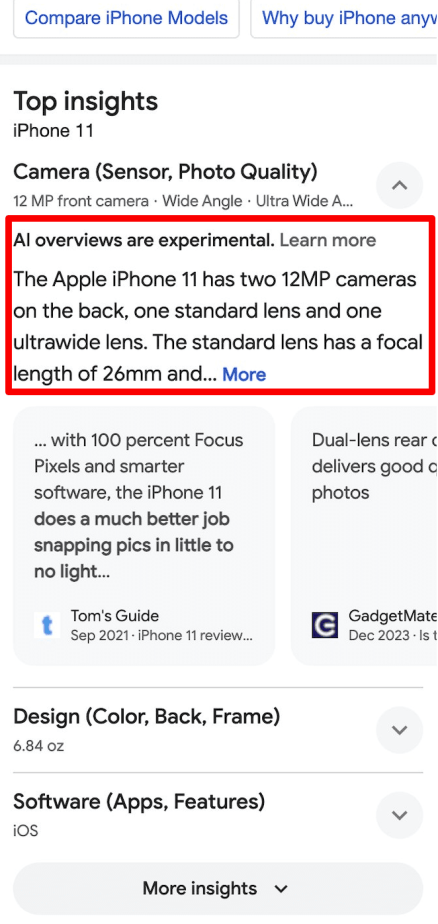

- Shopping tab, described in the previous section

- Google is also testing AI-generated overviews in place of the traditional local map pack for “near me” queries. Instead of a map and business listings, users are seeing summarized local information in the AI Overview format.
Not sure if this was a test or a bug, but I did a “service near me” type search where the AI Overview replaced the Map Pack. The AIO suggested I use Google to find what I was looking for… @rustybrick pic.twitter.com/AYazukdp0P
— Chris Lonergan (@cjlonergan) May 2, 2025
All versions resemble a simplified version of regular AIOs—a summary with links.
Note: In June 2025, AI Overviews—typically shown at the top of Google’s search results—were spotted appearing at the bottom of the page.
ページ最下部に出てくるAI Overviewをテスト中?このくらい下部に出るならCTRへの影響少なそうですね pic.twitter.com/H6QBQkeNCv
— 松下 聡太郎|コンテンツSEO (@w55UMqzEVGqD7FP) June 1, 2025
A look at the history of AI Overviews
- On 10 May 2023, Google announces the launch of Search Generative Experience (SGE) experiment during the annual Google I/O.
- On 25 May 2023, Google opens access to SGE for users who signed up for the waitlist.
- On 22 March 2024, Google starts testing AI Overviews in the main Google Search results, even if you had not opted into SGE.
- On 14 May 2024, at 2024 Google I/O, SGE was released from beta for the US market and rebranded into AI Overviews.
Its launch marked a shift in traditional search, kicking off a new era of SEO, where the focus is shifting toward optimizing websites for AI Overviews.

Other AI SERP elements
In addition to AI Overviews, during Google I/O 2024 the company announced the rollout of new Search Labs AI features, including planning capabilities, AI-organized search results, and Google Lens ask-with-video feature.
- Plan trips, activities, places to go
Google introduced a new feature that provides enhanced tourism recommendations through the traditional search bar. For instance, for a query like “5-day travel itinerary in Andalucia, Spain,” Google provided a detailed day-by-day plan with places to visit—including photos and ratings!—you can click to explore further.

A map below shows the results that reveal each location and the city as a whole.

Here’s something interesting: you can even interact with these results without leaving Google.
Don’t like the suggested activities? Simply customize them using the Replace and Add buttons.

Google also provides hotel options.

- Categorizing search results
This includes search results organized by web, including articles, videos, forums and more.
For example, for the query “vegetarian appetizer ideas,” Google displays various interactive blocks featuring recipes, ingredients, and more. Each block is clickable, directing you to the respective website. You can also save the recipe.
- Ask with Video in Google search
Users can now ask questions in video format. If a single picture isn’t enough to capture what you want to search for, Google Lens now lets you record a video and use your voice to ask about what you’re seeing. This feature generates an AI Overview and search results based on the video’s content and your verbal question. It’s available in Search Labs.
Google showcased how it works:
For example, if something breaks down, you can point your phone at it, open Google Lens, and hold down the shutter button to record the issue. While recording, you can ask questions like, “Why is it broken? How can I fix this problem?” Google Lens, powered by the Gemini AI model, will analyze the video and provide an answer, as shown in the video above. The goal is to make it quicker and easier to tell Google what you’re looking for. With a simple video, you can show Google everything it needs to assist you.
- AI-generated review summaries for movies
When you search for a movie and look at its reviews and ratings, Google uses AI to summarize both the positive and negative opinions under the AI Overviews label.
Below the summaries is a disclaimer that says, “AI Overviews are experimental.”
Google is showing AI-generated review summaries for movies.@rustybrick pic.twitter.com/4IdpWmto4t
— Shameem Adhikarath (@shemiadhikarath) February 21, 2025
- AI Overviews in Google Discover
In June 2025, Google began testing AI Overviews in the Discover feed. In July 2025, the company confirmed the official launch and began rolling it out in the US. Now, instead of seeing a headline from a major publication, users will see multiple news publishers’ logos in the top-left corner, followed by an AI-generated summary that cites those sources.

- Audio AI Overviews
Audio AI Overviews—AI-generated audio summaries for select US queries—are now available in Search Labs for desktop search.
Users can tap the Generate Audio Overview button within search results to hear an English-language summary powered by Gemini AI. The embedded audio plays after processing and includes source citations.
Audio Overview update: This was surreal to experience. I just triggered an audio overview about how Google’s core systems counterbalance each other. The overview was heavily based on my blog posts (and tweets) about the topic. They even used the factory analogy I used in my blog… pic.twitter.com/cbf4JgkDiG
— Glenn Gabe (@glenngabe) June 14, 2025
- Live voice chat with AI
As part of the Search Labs experiment, Google has rolled out Search Live in the Google app for both Android and iOS. Users can engage in real-time voice conversations with the Gemini-powered assistant—ask questions aloud, hear spoken answers, and continue the dialogue while links and a transcript appear on screen.
- Nano Banana image tool in Google Lens & Search Create mode
A new Nano Banana feature is now live in Google Lens. On Android and iOS, you can open Lens, tap Create (marked by a yellow banana icon), and generate or edit images by snapping or uploading a photo, then adding an instruction like “make a photo booth pic of me.” The feature currently works in English in the USA and India, with a broader rollout planned.
Wrapping up
As you may have noticed, AI Overviews are constantly evolving. Google adds new elements, changes the design, removes unnecessary features, expands locations, and more. To keep optimizing your content effectively, stay on top of these updates.
To do so, simply revisit this article periodically. It will always have the latest updates.

